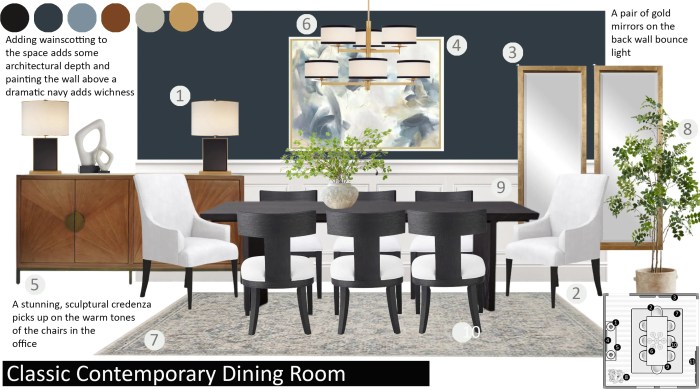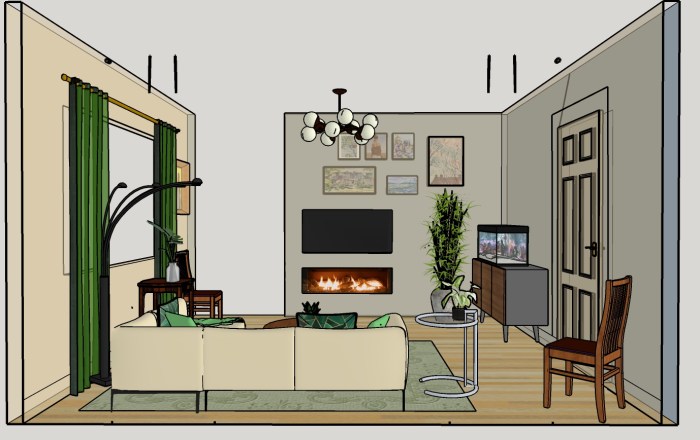Exploring the World of Virtual Interior Design
Diving into the realm of virtual interior design, this introduction captivates readers with a glimpse into a modern and innovative approach to designing spaces. From revolutionizing traditional methods to embracing cutting-edge technology, virtual interior design opens up a world of possibilities for designers and clients alike.
As we delve deeper, we uncover the intricacies of virtual tools, collaborative efforts, and emerging trends that are reshaping the interior design landscape in exciting ways.
Overview of Virtual Interior Design
Virtual interior design is the practice of designing and visualizing interior spaces using digital tools and software. In the modern world, virtual interior design has become increasingly popular due to its convenience, cost-effectiveness, and ability to provide realistic representations of design ideas before implementation.
Differences from Traditional Interior Design
Virtual interior design differs from traditional methods in various ways. Unlike traditional interior design, virtual interior design allows designers to create 3D models of spaces, experiment with different layouts and color schemes, and visualize the final result in a realistic manner.
This eliminates the need for physical prototypes and reduces the risk of costly mistakes during the design process.
Benefits of Virtual Tools
- Enhanced Visualization: Virtual tools enable designers to create detailed 3D models of spaces, allowing clients to visualize the final design more accurately.
- Cost-Effective: By eliminating the need for physical prototypes and reducing the risk of errors, virtual interior design can help save costs during the design process.
- Efficient Communication: Virtual tools facilitate communication between designers, clients, and other stakeholders by providing a visual representation of the design ideas.
- Increased Flexibility: Virtual interior design allows for easy experimentation with different design concepts, layouts, and materials, leading to more creative and innovative solutions.
Virtual Interior Design Software
Virtual interior design software plays a crucial role in creating stunning and functional interior spaces without the need for physical prototypes. Let's explore some popular software options and how they can enhance the design process.
List of Popular Software
- 1. Autodesk AutoCAD: Known for its precision and 2D/3D modeling capabilities.
- 2. SketchUp: User-friendly interface with powerful 3D modeling tools.
- 3. Chief Architect: Ideal for detailed floor plans and interior design.
- 4. Blender: Open-source software with advanced rendering features.
Comparison of Features
| Software | Key Features |
|---|---|
| Autodesk AutoCAD | Advanced 2D/3D modeling, precise measurements, collaboration tools. |
| SketchUp | Intuitive interface, extensive library of 3D models, easy exporting. |
| Chief Architect | Detailed floor plans, interior design tools, realistic rendering. |
| Blender | Powerful rendering, animation tools, customizable interface. |
Enhancing the Design Process
Virtual interior design software allows designers to:
- Visualize designs in 3D before implementation, saving time and resources.
- Experiment with different layouts, colors, and furniture arrangements easily.
- Create realistic renderings and walkthroughs to help clients better understand the final look.
- Collaborate with clients and team members remotely, enhancing communication.
Virtual Reality in Interior Design
Virtual reality technology has brought a significant revolution to the interior design industry, offering immersive experiences and transforming the way designers interact with clients and visualize projects.
Impact on Client Presentations and Project Visualization
Using virtual reality in interior design allows designers to create realistic 3D environments that clients can explore in real-time. This technology enables clients to visualize the final design concept before any physical changes are made to the space. By immersing clients in a virtual environment, designers can effectively communicate their ideas and ensure that the client's vision aligns with the final outcome.
This level of interaction enhances the client experience and streamlines the decision-making process, ultimately leading to greater satisfaction and successful project outcomes.
Advantages of Using Virtual Reality for Immersive Interior Design Experiences
Enhanced Visualization
Virtual reality enables designers and clients to experience the space from different perspectives, making it easier to make informed decisions about layout, colors, materials, and furniture placement.
Time and Cost Efficiency
By visualizing the design concept in a virtual environment, designers can identify potential issues early on and make necessary adjustments before any physical work begins. This helps save time and reduce costly mistakes during the construction or renovation process.
Personalized Design Experience
Virtual reality allows clients to actively participate in the design process, providing feedback and making changes in real-time. This collaborative approach ensures that the final design reflects the client's preferences and requirements, leading to a more personalized and satisfying outcome.
Sustainable Design Practices
Virtual reality technology can simulate the use of sustainable materials and energy-efficient solutions, helping designers and clients make environmentally conscious design choices. By visualizing the impact of these choices in a virtual environment, stakeholders can make informed decisions that contribute to a more sustainable future.
Virtual Interior Design Process

Creating a virtual interior design project involves a step-by-step process that seamlessly integrates technology with design principles. Transitioning from traditional design to virtual design requires careful consideration of key factors to ensure a successful outcome. Utilizing virtual tools effectively can enhance the design process and lead to stunning results.
Step-by-Step Process
- Begin by gathering client requirements and preferences to understand their vision for the space.
- Use virtual interior design software to create a 3D model of the space, including walls, windows, and doors.
- Select and place furniture, decor, and other elements to design the virtual room according to the client's specifications.
- Experiment with different layouts, colors, and textures to refine the design and achieve the desired aesthetic.
- Collaborate with the client to make adjustments and finalize the virtual design before implementation.
Key Considerations
- Understand the capabilities and limitations of virtual design tools to maximize their potential in the design process.
- Ensure clear communication with clients to accurately translate their ideas into virtual designs.
- Adapt traditional design skills to the digital environment by learning new software and techniques.
Tips for Utilizing Virtual Tools
- Take advantage of virtual reality technology to provide clients with immersive experiences and realistic simulations of the design.
- Use virtual tools for quick iterations and adjustments to design elements without the need for physical prototypes.
- Explore different lighting effects and perspectives in the virtual environment to enhance the overall look and feel of the design.
Collaborative Virtual Design

Virtual interior design plays a crucial role in facilitating collaboration among designers, clients, and other stakeholders involved in a project. By leveraging technology and virtual platforms, teams can work together seamlessly despite physical distances, leading to enhanced communication and productivity.
Successful Collaborative Virtual Design Projects
- One successful example of collaborative virtual design is the renovation of a luxury hotel where designers, contractors, and clients worked together in a virtual environment to visualize and make real-time changes to the interior design elements. This collaborative effort resulted in a stunning final outcome that met all stakeholders' expectations.
- In another project, a team of interior designers and architects collaborated virtually to design a modern office space for a tech company. Through virtual reality simulations and shared design tools, the team was able to iterate quickly on ideas, gather feedback from the client, and finalize the design efficiently.
Challenges and Benefits of Collaborative Virtual Design
- Challenges:
- Technical difficulties and glitches in virtual design software can hinder real-time collaboration and cause delays in the project timeline.
- Ensuring effective communication among team members, especially when working remotely, can be a challenge that needs to be addressed through clear guidelines and protocols.
- Managing different design preferences and ideas from multiple stakeholders can sometimes lead to conflicts that require careful mediation and compromise.
- Benefits:
- Enhanced communication and transparency among team members, leading to better coordination and alignment on project goals.
- Cost savings by reducing the need for physical meetings and site visits, as virtual design tools allow for remote collaboration from anywhere in the world.
- Increased efficiency in the design process, with the ability to make instant changes and updates to the design based on real-time feedback from clients and stakeholders.
Virtual Interior Design Trends
In the ever-evolving world of virtual interior design, keeping up with the latest trends is crucial to stay ahead of the game and provide innovative solutions to clients. Let's explore some of the current trends shaping the virtual interior design industry and how technology advancements are playing a significant role in defining the future of this field.
Integration of Artificial Intelligence
Artificial Intelligence (AI) is revolutionizing the way virtual interior design is approached. From automated design suggestions based on user preferences to virtual assistants helping designers streamline their workflow, AI is becoming an integral part of the design process.
Sustainable Design Practices
With an increased focus on sustainability and environmental consciousness, virtual interior design is embracing eco-friendly practices. Designers are using virtual tools to simulate the environmental impact of materials and make more sustainable choices in their designs.
Immersive Virtual Reality Experiences
Virtual Reality (VR) technology is taking virtual interior design to a whole new level by offering immersive experiences to clients. Designers can create virtual walkthroughs of spaces, allowing clients to visualize the final design in a realistic and interactive way.
Personalization and Customization
Clients today are looking for personalized and unique design solutions that reflect their individual style and preferences. Virtual interior design tools are enabling designers to create customized spaces tailored to the specific needs and tastes of each client.
Collaborative Design Platforms
Collaboration is key in virtual interior design, and designers are increasingly turning to collaborative platforms to work with clients, architects, and other stakeholders in real-time. These platforms facilitate communication, feedback, and decision-making throughout the design process.
Virtual Staging for Real Estate
Virtual staging is gaining popularity in the real estate industry as a cost-effective and efficient way to showcase properties. Virtual interior design allows realtors to digitally furnish and decorate empty spaces, attracting more potential buyers and increasing property value.
Concluding Remarks
In conclusion, virtual interior design is not just a trend but a transformative force in the industry, offering endless creative opportunities and enhancing the overall design experience. As technology continues to advance, the future of interior design looks brighter and more immersive than ever before.
Popular Questions
What is virtual interior design?
Virtual interior design is the use of digital tools and technology to create simulated environments for designing and visualizing interior spaces.
How does virtual interior design differ from traditional methods?
Virtual interior design offers a more interactive and immersive design experience compared to traditional methods, allowing for better visualization and collaboration.
What are the benefits of using virtual tools for interior design projects?
Virtual tools help streamline the design process, reduce costs, and provide a more realistic preview of the final design outcome.